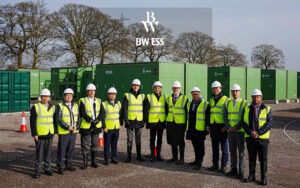Two of Australia’s biggest network operators – Ausgrid and United Energy – have outlined plans to invest in community-scale battery storage in moves that will boost the grid’s capacity to absorb more rooftop solar, and also put network companies on a collision course with the major energy retailers.
Ausgrid, which services a large part of the Sydney metropolitan area, and the region to the city’s north, has identified the locations of the first three community batteries that it wants to trial – boosting the capacity of the local grid to absorb rooftop solar, and avoiding the need for network upgrades.
United Energy, which services south-east Melbourne suburbs and beyond, has a slightly different approach – proposing around 30 “pole mounted” batteries, rather than bigger ground mounted installations, but which will serve much the same purpose – increasing the capacity of the local grid to absorb rooftop solar, and avoiding network upgrades.
Community-scale batteries have been championed particularly in Western Australia, where the network provider Western Power has been installing numerous Tesla Powerpacks, in formations of around 500kWh, to stop reverse flows on “weak” parts of the networks, and offering localised storage to solar households in the area.
Community batteries are a key plank of the WA government’s distributed energy roadmap, and are happening there first because there are fewer regulatory hurdles to overcome, and because the state owns the major network, generators and retailers.
But the significance of the move by privately owned network operators into “community storage” on Australia’s main grid is not just in the amount of rooftop solar that can be supported, it also points to growing tension between networks and traditional “gentailer” utilities over the business model of the future.
Networks privately, and occasionally publicly, declare that they will be critical to the future of the energy systems because they provide the delivery mechanism (the poles and wires) for generation, storage and sharing, and are keen to get “close to consumers”.
They think the retailers, given the reduced emphasis on centralised generation, and the fallibility of the retailer model (basically just packaging up data and bills fr consumers) do not have a long term future. The retailers have recognised the threat of remaining little more than a “middle man” and are therefore focusing also on battery storage, electric vehicles and other plans to fully engage the customer.
In W.A., the state-owned “gentailer” Synergy says it is about to unveil a “whole new business strategy” that recognises the switch to a decentralised, digitalised and democratised grid. Chairman Robert Cole said in the newly released annual report that it would become a “new and different organisation with a sustainable future in the evolving and complex new energy market.”
In the eastern states, the legacy “gentailers” and smaller retailers see the same threat, and are also active in projects that are looking at virtual power plants and EVs.
But they are protected – at least for the moment – by “ring fencing” regulations that prevent the networks from entering their part of the energy business, and getting close to those consumers, which is why United has had to seek a special exemption to be able to hang batteries from its power poles and make storage offerings to consumers (albeit through a retailing partner).
United is looking to install 40 BESS (battery energy storage systems) sized at 30kW/75kWh each, and mounted on power poles at capacity-constrained distribution substations and on low-voltage circuit.
The idea is to charge them at times of low prices (overnight or as a solar sponge in the middle of the day), to store power for use at peak times, and to play in the FCAS (frequency control) markets. They will support network voltage by absorbing or supplying reactive power.
United Energy says the trial should demonstrate how they can defer network spending, offer new services,, and open up new storage options where the installation of batteries is – ironically – constrained by the prevalence of household air conditioning units.
“The installation of BESS units facilitates a transition to a low-carbon future,” it says in its submission to the regulator for a ring-fencing exemption.
“To date, residential behind-the-meter batteries have not been able to keep pace with solar PV installations in sufficient numbers to deliver customers with maximum value for their solar investment, nor deliver lower electricity charges for all other customers.
“This is because the lack of batteries relative to solar PV is contributing to network voltage-rise issues in many distribution networks and this is curtailing solar PV exports.
“Furthermore, in areas of the network where there are network capacity-constraints associated with residential peak air- conditioning demand, there are insufficient behind-the-meter batteries available to support the network during the early evening peak periods and avoid the need for network augmentation.”
Ausgrid, has been talking about community battery storage for several years, as well as getting “closer to customers”, and after a feasibility study was completed by KPMG has now chosen its preferred areas for a multi-year trial of three 500kWh batteries – Sydney’s northern beaches, Canterbury-Bansktown and Lake Macquarie, although the exact locations are still not decided. It does not believe it needs a formal exemption for its limited trial.
“A community battery allows solar customers to use all the clean energy they generate, save on their electricity bills, and get more value from their solar investment, without needing to own and maintain their own household battery system,” CEO Richard Gross said in a statement.
“We want to be part of a green energy future and it’s our ambition to deliver industry-leading sustainable energy solutions for our customers.”
Ausgrid says that solar customers will benefit from avoiding battery installation and maintenance costs, and will be able to choose unique storage levels for their individual needs. But it has not released exact details of the tariffs they will receive for storing the output of their rooftop solar PV, rather than sending it back to the grid, or the cost of drawing the power down from the battery.
The KPMG report canvassed various options for tariffs, and how to manage “credits” for households if they didn’t draw down their stored solar each day. It noted, for instance, a daily “re-set” would significantly reduce savings for consumers. It talked of battery “package” sizes of 2, 4, 6 and 8 kWh of energy storage per day per consumer, depending on the solar system size.
The various options canvassed included a range of “battery service” charges, up to around $320 a year, but suggested that the households could save around $216 a year, net of the service charge – which may not sound very grand to some, but would avoid the capital costs of batteries, uncertainty over their payback, and offer increased grid resilience.
The KPMG report also highlighted the regulatory barriers to community batteries, noting that Ausgrid could operate them as a network service only, but would require exemptions or partnerships to deliver other market benefits contemplated by the utility. It found that some configurations of the battery could deliver net commercial benefit within three years.











